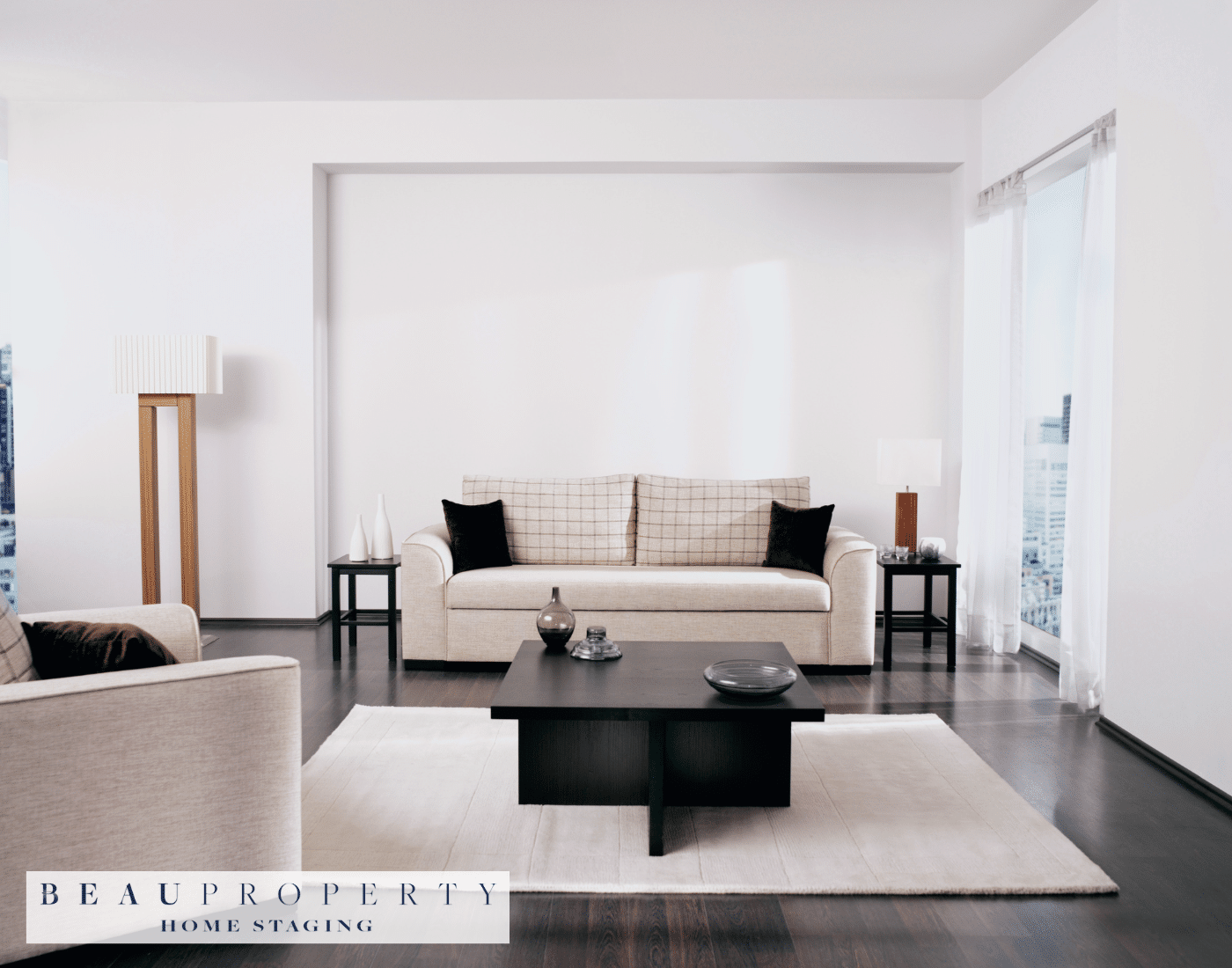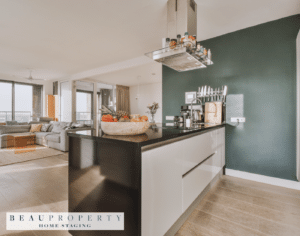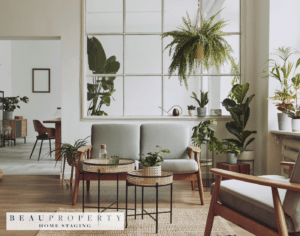First Impressions Matter
Importance of Curb Appeal
First impressions are crucial in home staging. A significant 99% of NAR members believe that curb appeal plays an essential role in attracting buyers. This isn’t just about aesthetics; it’s also about setting the mood for the entire walkthrough. A pleasant exterior can enhance buyers’ perception of the interior, while a neglected one might make it difficult to win them over.
Upgrading the Front Door
One of the most impactful and relatively affordable ways to boost your home’s curb appeal is by upgrading the front door. A new front door can offer a return on investment of approximately 75%. The door is the focal point of your home’s façade, so ensure it’s not only in good condition but also visually appealing. Begin by painting the door in bold or classic colours that complement your home’s exterior.
Additionally, consider replacing worn-out hardware and installing a stylish door knocker. Layering doormats and adding potted plants or flowers on either side can further enhance the entry’s charm. It’s also important to upgrade lighting fixtures to make the space welcoming and safe.
Creating an Inviting Entryway
After sprucing up the front door, focus on creating an inviting entryway. Start by ensuring the pathway and porch are clean and free of any debris. Potted plants and fresh-painted railings can add a touch of vibrancy and make the space feel more welcoming. Layering up lighting is another essential element. It highlights the entryway and improves visibility during evening showings.
Mirrors are excellent for bouncing light and making the area appear more spacious. Additionally, consider incorporating a small bench or seating area if the space allows, to create a functional and inviting spot for visitors.
By focusing on these aspects, you ensure that the first impression is not just good, but extraordinary. This sets a positive tone for the rest of the house and makes potential buyers eager to see more.
Declutter and Depersonalise
Removing Personal Items and Clutter
A cluttered home can leave a negative impression on potential buyers. Therefore, the initial step in staging is to eliminate unnecessary items. Start by tackling one room at a time, from the smallest to the largest. Retain only essential items, and donate or discard anything that’s no longer in use. Pack away possessions you wish to keep but don’t currently need, storing them elsewhere.
Creating a Neutral Space for Buyers
The goal is to create a neutral canvas that allows potential buyers to envision themselves living in the home. To achieve this, remove personal items like family photos, unique decor, and highly personalised furniture. Reducing these personal touches helps depersonalise the space, enabling buyers to focus on the home’s features rather than your belongings. This makes the space appear larger and more welcoming.
Highlighting the Home’s Strengths
Decluttering and depersonalising not only eliminates distractions but also highlights your home’s strengths. By presenting a clean, neutral space, you can showcase architectural details and functional areas more effectively. A well-staged home allows buyers to imagine how they would use the space, potentially speeding up the sale process and increasing the home’s appeal.
Brief Transition
When staging your home, always keep in mind that the ultimate aim is to create an environment where buyers can picture themselves. A clean, neutral space does just that, setting the stage for the next steps in enhancing your home’s appeal.
Deep Clean and Refresh
Importance of a Thorough Cleaning
A deep clean is crucial for home staging as it significantly enhances the home’s appeal. A spotless home not only looks more inviting but also indicates good maintenance. Potential buyers are more likely to view a clean house positively, as it suggests the property has been well-cared for, thus giving them peace of mind about potential hidden issues. Deep cleaning targets areas often overlooked, such as grout, light fixtures, and baseboards, restoring their original shine and making the home feel fresher and more welcoming.
Addressing Minor Repairs
Minor repairs can have a substantial impact on the perception of your home. Issues like cracked sidewalks, scuffed woodwork, and chipped lighting fixtures can give buyers the impression that bigger problems may also exist. Addressing these minor issues can enhance the overall presentation of your home and reassure potential buyers that the property is in top condition. Simple fixes, such as replacing torn screens or tightening loose fixtures, can eliminate distractions and help buyers focus on the positives.
Freshening Up with Neutral Paint Colours
Neutral paint colours are a timeless choice that can appeal to a broad range of tastes. Colours like light greys, beiges, and whites create a calm and tranquil atmosphere, allowing potential buyers to envision their personal style in the home without feeling overwhelmed by bold colour choices. Using neutral tones throughout the home not only harmonises the overall appearance but also aids in visually expanding the space. Fresh coats of paint can significantly rejuvenate a room, making it look well-maintained and modern, thereby enhancing its appeal.
Preparing your home for sale involves more than just surface-level cleaning; it requires a deep clean, minor repairs, and aesthetically pleasing updates like fresh, neutral paint. This comprehensive approach helps create an immaculate, move-in-ready impression that encourages buyers to imagine themselves living in the space. Preparing a home with such thoroughness can accelerate the sale process and potentially increase the property’s market value.
Next, we will explore ways to maximise the space and light within your home to further captivate potential buyers.
Maximise Space and Light
Enhancing a home’s appeal by optimising space and light can significantly improve its attractiveness to potential buyers. This chapter covers practical techniques to maximise both these elements.
Rearrange Furniture to Optimise Flow
Rearranging furniture can transform the feel of any room. Start by keeping the function of the room in mind and determining its focal point, such as a fireplace or a large window. Position the largest pieces of furniture first, such as sofas and beds, to anchor the space. From there, arrange smaller pieces to create a natural flow that allows for easy movement throughout the room. This approach ensures that the layout is functional and inviting, enhancing the room’s overall appeal.
Utilise Mirrors and Lighting Techniques
Mirrors are a powerful tool in staging, particularly in small or dimly-lit spaces. Place mirrors across from windows to reflect natural light, thereby brightening the room and giving the illusion of more space. Another effective technique is to use large mirrors to make a room appear larger.
Lighting, too, plays a crucial role. Embrace natural light as much as possible by keeping windows unobstructed. Layering different types of lighting, such as ambient, task, and accent lighting, can add depth and warmth to the room, making it more inviting.
Showcase Potential Functional Areas
Staging involves more than just making a home look presentable; it’s about showcasing how a space can be utilised. Identify potential functional areas within each room and emphasise their uses. For instance, a nook can be staged as a reading corner, and an empty room as a home office or gym. Highlighting these potential uses helps buyers envision different possibilities for the space, increasing its market appeal.
By effectively rearranging furniture, utilising mirrors and lighting, and showcasing potential functional areas, you can maximise space and light in your home. This approach not only enhances aesthetics but also makes it easier for buyers to imagine themselves living there, ultimately making the home more attractive.
Next, focus shifts to key rooms that often make the most significant impact on potential buyers.
Focus on Key Rooms
Prioritising Living Room, Kitchen, and Master Bedroom
When staging a home, concentrating on the key rooms—namely, the living room, kitchen, and master bedroom—can significantly impact a buyer’s perception. These central areas often make the strongest impression, influencing a buyer’s decision to purchase.
Living Room
The living room is often the first interior space a potential buyer will encounter. Thus, creating an inviting and cohesive environment here is imperative. Start by arranging the furniture to highlight the room’s focal points, be it a fireplace or a large window. Use a neutral colour palette to maintain broad appeal, and add pops of colour through accessories like throw pillows and artwork to create interest. Try to keep the layout airy and clutter-free to make the room appear more spacious.
Kitchen
As the heart of the home, the kitchen should embody functionality and style. Ensure that counters are clear of clutter, allowing potential buyers to appreciate the workspace. Freshen up cabinets with a new coat of paint or updated hardware, which can make an old kitchen feel modern. Highlight unique features like a breakfast nook or high-end appliances to convey the kitchen’s full potential. Adding a bowl of fresh fruit or a vase of flowers can bring a welcoming touch.
Master Bedroom
The master bedroom should evoke a sense of tranquillity and comfort. Use neutral bedding with textured layers to create a luxurious feel. Arrange furniture to optimise floor space, giving the room an open and airy vibe. Introduce a seating area if space allows, which can suggest a relaxing retreat within the home. Accent lighting, like bedside lamps or reading lights, can also enhance the room’s ambience.
Creating Inviting and Functional Spaces
Creating distinct zones within these key rooms can help showcase their functionality. For instance, in the living room, defining a reading corner or setting up a small workspace can appeal to buyers looking for multifunctional spaces. In the kitchen, setting up a coffee station can add a cosy yet functional touch. Ensuring each zone flows seamlessly into the next is crucial for maintaining a cohesive design without feeling cluttered.
Highlighting Unique Architectural Features
Every home has unique architectural elements that set it apart, such as exposed brick, crown moulding, or a bay window. Using accent lighting to draw attention to these features can enhance their impact. Choose decor that compliments these elements, further integrating them into the overall aesthetic of the home. For example, a bay window can be staged with a reading nook to emphasise its potential as a serene space.
Focusing on these key areas while staging will help you create a lasting impression on potential buyers, showcasing the home’s best features and functionality. By putting effort into these rooms, you can transform ordinary spaces into extraordinary ones that buyers can’t resist.
The Power of Neutrals and Accents
The use of neutral colours in home staging lays the foundation for a universally appealing environment where potential buyers can easily imagine themselves. A backdrop of light greys, beiges, and whites ensures the home feels spacious, clean, and inviting. This creates a necessary blank canvas that highlights the home’s architectural beauty and offers a versatile backdrop for personal touches.
Using a Neutral Colour Palette as a Base
Neutral tones are favoured for their ability to make spaces feel larger and more cohesive. These tones, often inspired by elements found in nature like sand, rocks, and shells, create a calm, harmonious ambiance throughout the home. Such an environment allows potential buyers to visualise their furniture and decorative items within the space, enhancing the likelihood of an emotional connection to the home. For optimal results, it’s recommended to keep the neutral shades consistent across all rooms to maintain a cohesive look under different lighting conditions.
Adding Pops of Colour with Accessories
While a neutral base is essential, accent colours bring vibrancy and personality into the home staging process. This technique, commonly referred to as the 60-30-10 rule, suggests that 60% of the room should be a dominant colour, 30% a secondary colour, and the remaining 10% should be an accent. Choosing one or two bold accents, such as vibrant throw pillows or eye-catching wall art, can significantly enhance a neutral room without overwhelming it.
Here are some effective accent colours and their emotional appeal:
- Light Blue: Conveys serenity and is reminiscent of the sky and ocean, producing a calming effect.
- Green: Associated with nature, it is refreshing and can be added through potted plants or artwork.
- Yellow: Adds energy and warmth, perfect for throwing pillows or small decor items.
- Orange: Provides vibrancy and is particularly effective in outdoor spaces, hinting at fun and leisure activities.
Creating a Cohesive Design Throughout the Home
The ultimate goal of using neutrals and accents is to create a cohesive design that flows seamlessly from room to room. Inconsistencies in colour schemes can disrupt this flow and make the home feel disjointed. Instead, maintaining a consistent neutral base, combined with carefully placed accents, ensures that each area of the home complements the others. Accents should be balanced and not crowd the space; a few well-chosen pieces can draw attention to the home’s best features without overwhelming the buyer.
By paying attention to these details, you can create an appealing, unified environment that makes a strong impression on potential buyers.
All of these efforts culminate in a home that resonates with a broad audience, enhancing its market appeal and increasing the likelihood of a swift sale at a favourable price.
Outdoor Living Spaces
Creating an inviting outdoor space is a pivotal element in home staging. Potential buyers often envision themselves entertaining, relaxing, and enjoying time outside. Transforming patios, decks, and gardens into appealing and functional areas can significantly enhance the home’s overall appeal.
Staging Patios, Decks, and Gardens
First, focus on decluttering and cleaning outdoor spaces. Remove any personal items such as family memorabilia or peculiar decorations, including lawn gnomes and garden flags, to create a neutral canvas. Aim for a balanced atmosphere where potential buyers can easily imagine their lifestyle fitting into the space.
Introduce quality outdoor furniture to showcase potential uses of these areas. Comfortable seating arrangements, such as a couch with weather-resistant cushions, can turn a patio into a cosy lounge spot. Dining sets and a well-placed grill can depict an inviting space for summertime meals. Enhance greenery by adding potted plants and arranging them thoughtfully to create a soothing environment.
Creating Outdoor Entertainment Areas
Outdoor entertainment zones can be a significant selling point, especially for families who value shared activities. Designate areas within gardens or patios for specific functions. For example, set up a corner with a fire pit surrounded by seating for evening gatherings. You might also include a water feature or a barbeque area to add sophistication and functionality.
Consider aspects such as shade and privacy; incorporate elements like pergolas and outdoor curtains to provide cover and seclusion. This ensures the space is usable and comfortable across different weather conditions.
Highlighting the Connection Between Indoor and Outdoor Spaces
A seamless transition between indoor and outdoor areas can make the home feel more spacious and integrated. Large glass doors, bi-fold doors, or even accordion doors can blur the lines between the interior and exterior. Using consistent flooring materials, such as extending wooden floors from the living room onto the deck, can strengthen this cohesion.
Natural elements can also carry this theme. Bringing plants indoors and using materials like stone and wood in both environments enhances the connection. Position outdoor seating areas to complement indoor spaces, such as placing a patio lounge opposite a living room sofa on either side of glass doors. This visual alignment helps buyers see the holistic potential of the home.
By thoughtfully staging outdoor spaces, you can create an alluring and functional environment that resonates with potential buyers. Each element, from the furniture to the natural decor, plays a role in presenting a home that is not only beautiful but livable, enhancing its marketability.
The 3-Foot 5-Foot Rule
Understanding the Concept
The 3-Foot 5-Foot Rule is a powerful guideline in home staging that focuses on ensuring every area looks appealing both from a distance and up close. This involves detailing at two specific distances: three feet and five feet. At three feet, buyers should notice small details and textures that maintain their interest. At five feet, the overall design should be cohesive and inviting, pulling them in to explore further.
Creating Cohesive Designs
A well-staged home should present a unified and harmonious look. This means careful consideration of room layout, colour scheme, and decorative items. The goal is to create a design that seamlessly connects each element, making the room feel balanced and welcoming. For instance, maintaining a consistent colour palette throughout the home helps to create that cohesive look that appeals to buyers.
Up-Close Details That Captivate
When buyers inspect a room closely, it’s essential that they find details that enhance their experience. Textures, finishes, and small decor items should be strategically placed to captivate their attention without overwhelming them. This could include a well-chosen piece of artwork, luxurious fabric, or an eye-catching light fixture. Each detail should contribute to the overall aesthetic without standing out awkwardly or seeming out of place.
Following the 3-Foot 5-Foot Rule ensures that buyers remain engaged whether they are entering a room for the first time or inspecting details up close. Each view and interaction with the space should reinforce their interest and help them envision living in the home.
With these strategies in play, we boost the home’s appeal and create lasting, positive impressions.
Virtual Staging Techniques
Utilising Virtual Staging for Online Listings
Virtual staging has revolutionised the real estate market, offering a cost-effective and efficient way to present properties attractively. By using digital tools to place furniture and decor into high-resolution images, sellers can enhance empty or outdated spaces without the expense of physical staging.
Virtual staging software like Homestyler allows real estate agents to create photorealistic interior designs quickly. Agents start by taking photos of the property, then add items from a vast library of real interior design pieces. Users can drag and drop these elements to transform the space.
Moreover, 360° virtual staging offers an interactive panoramic view, making it possible for buyers to virtually explore the property as if they were there in person. This immersive experience can significantly improve the buyer’s engagement and interest in the property.
Showcasing the Home’s Potential Without Physical Staging
One of the key benefits of virtual staging is its ability to showcase a home’s potential. By digitally placing furniture and decor, sellers can help buyers visualise how each room can be used. This method is versatile, allowing for quick adjustments to suit different target markets. For instance:
- Family-focused staging can include child-friendly rooms or play areas.
- Executive-focused staging can highlight home offices or professional spaces.
- Outdoor spaces can be enhanced with virtual furnishings, showcasing patios and gardens.
Virtual staging tools also enable agents to demonstrate potential renovations, such as adding new countertops or flooring, which can make older properties appear modern and appealing without actual physical changes.
Creating a Strong First Impression in Digital Spaces
First impressions are vital in real estate, and virtual staging can play a significant role in capturing a buyer’s interest. High-quality, virtually staged images inserted into online listings can make a substantial difference. By using virtual staging, properties can be presented in the best possible light, highlighting strengths and downplaying weaknesses. This can result in faster sales and better offers.
Implementing virtual staging techniques effectively ensures that properties make a memorable impact on buyers from their first online interaction, setting the stage for a successful sale.
As we continue to enhance the charm of properties, the next focus will be ensuring the final touches and atmosphere align with these modern staging techniques.
Final Touches and Atmosphere
Adding Fresh Flowers or Plants
Incorporating fresh flowers or plants into your home staging can elevate the environment dramatically. Flowers such as chrysanthemums, marigolds, and petunias are excellent choices due to their vibrant colours and easy maintenance. These additions introduce warmth, colour, and a touch of nature, enhancing the overall appeal of the home. For those selling in cooler months, consider pansies, mums, or even ornamental kales and cabbages for a seasonal touch. Eucalyptus, although not a flower, is a versatile complement to any floral arrangement, adding texture and a subtle yet invigorating scent.
While real plants are ideal, silk flowers and greenery can also be used to avoid the upkeep required by live plants. Just ensure they are high-quality, dust-free, and realistic to prevent them from becoming a distraction.
Creating a Pleasant Scent Throughout the Home
The sense of smell plays a crucial role in forming buyers’ impressions. Use citrus scents such as lemon, orange, or grapefruit, known for their clean and fresh characteristics. You can achieve these naturally by running a lemon or orange peel through your garbage disposal. Freshly washed laundry or a subtle lavender scent are also appealing options. Essential oils should be used sparingly, whether in diffusers or sprays, to prevent an overpowering fragrance.
A tried-and-true method for a cosy home scent is potpourri on the stove, using ingredients like apples, oranges, cinnamon sticks, and cloves. This not only fills the home with a pleasant aroma but also offers an eco-friendly solution to artificial air fresheners.
Ensuring Proper Temperature and Lighting During Showings
Ideal temperature and lighting are critical in making a home feel inviting. Set the home’s temperature to a comfortable level, around 21°C (70°F), to ensure potential buyers feel at ease. Avoid extremes that could make the space feel uninviting.
Lighting should emulate natural sunlight as much as possible. Use daylight bulbs with a colour temperature between 5000K to 5500K. These bulbs accurately render colours and give the home a welcoming glow, making spaces appear larger and more inviting.
A well-lit home ensures that every corner is effectively highlighted, making it easy for buyers to appreciate the home’s features. Whenever possible, let in natural light by keeping curtains and blinds open.
Final touches like fresh flowers, clean scents, and optimal temperature and lighting can transform the home atmosphere significantly. These elements create a sense of warmth and welcome, setting the stage for a successful sale






